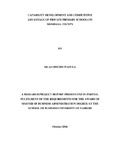| dc.description.abstract | This study sought to establish the effect of capability development on competitive
advantage of private primary schools in Mombasa County. The study followed a
descriptive research design and collected primary data mainly through selfadministered
questionnaires. The target population was the private primary schools in
Mombasa County. The researcher used stratified random sampling. The four strata were
the sub-counties in Mombasa county namely, Changamwe, Likoni, Mvita, Kisauni. The
target sample was 50 schools, and ensured at least 10 each from a sub county. The target
respondents were private primary schools proprietors, partners and head teachers from
schools under review. In total, 48 fully completed questionnaires were collected which
is equal to 96% response rate. The results established that 50% of the schools have less
than an acre piece of land while 33.3% of the schools are built on exactly one acre. Also,
the finding established that the schools have an average of 34 teachers: 19 male and 15
female. Further, the schools rely on fees as their major source of financing, and apply
stringent debt (fee) collection, whereby the parents were required to pay school fees
within the first week of each new term. In addition, the schools have reasonable facility
to support learning and co-curricular activities. The data adhered to regression
assumptions; normality, homoscedasticity, multicollinearity and autocorrelation. The
obtained R and R-Square statistics were 0.738 and 0.544 respectively. Since the
coefficient of determination R was positive, there is a positive relationship between
capability development and a school’s strategic advantage as measured by the school
performance. A Pearson product moment of correlation (R-Square) of 0.544 indicates a
moderately strong relationship. The obtained coefficients for capability development as
measured by the predictor variables; Physical infrastructure, Human resources, Financial resources, Intellectual resources were large and positive, and their
corresponding p-values were all less than 0.05, hence the coefficients were statistically
significant. The study concludes that there is a positive moderately strong relationship
between capability development and strategic advantage of a school. In the light of the
findings, the study recommends that managers of private schools should apply
competitive strategies in order to gain sustainable competitive advantage. | en_US |



